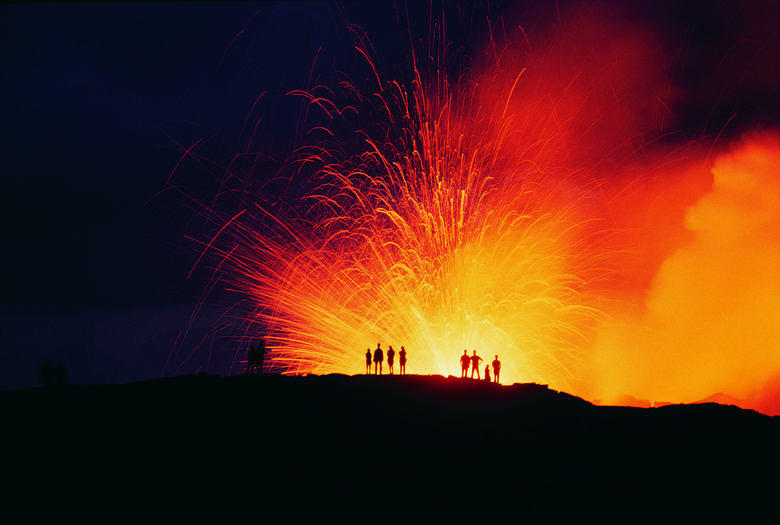What Happens When The Central Vent Of A Volcano Gets Blocked?
A volcano consists of a fissure or vent in the crust of the earth that allows magma to flow up from below. An open, active volcano will occasionally expel gas and magma through this vent, reducing the pressure in the magma chamber below. If something blocks this vent, however, it can lead to a spectacular eruption and an extremely dangerous situation for anyone nearby.
Vent Blockages
Vent Blockages
A vent blockage can occur for internal or external reasons. Sometimes the consistency of the magma flowing to the surface becomes thick and viscous, and ends up plugging the vent as it ascends. In other cases the rim of a volcano may collapse and fall back into the vent, blocking it with debris. In June of 2009, a rockfall partially blocked a major vent of the Kilauea volcano, but other vents relieved the pressure and prevented a major eruption.
Pressure and Eruptions
Pressure and Eruptions
A blocked vent can prevent material from flowing out of the volcano, but it cannot prevent the upwelling of magma that caused the flow in the first place. In most cases a blockage is only temporary, until the pressure builds up enough to clear the plug. If the blockage is extensive, through either a major cinder cone collapse or a long period of inactivity allowing thick magma to solidify into a solid barrier, the pressure may build up enough to cause an eruption. When this occurs, the forces involved can propel magma, gas and ashes with considerable force, creating a pyroclastic flow.
Types of Eruptions
Types of Eruptions
Volcanoes can erupt in many different ways, and vulcanologists often name them after famous volcanoes that exhibited a given type of eruption. A Vulcanian eruption results in a large cloud of ash and gas high over the volcano, while a Pelean eruption produces avalanches of lava fragments and other pyroclastic material that move very quickly down the slope of the cone. Plinian eruptions are common with major vent blockages: the force projects material and gas over a large distance and creates powerful flows of superheated ash, lava and mud that can completely reshape the environment around the mountain. The eruption of Mount St. Helens in 1980 was a Plinian eruption, and actually blew out the side of the mountain rather than going straight up through the vent.
Volcanic Plugs
Volcanic Plugs
In some cases, a blocked vent may cause the magma reservoir to redirect its energy to other vents, and the material in the original vent can solidify into rock. If the cinder cone, made up of less dense material, erodes away, it can leave a cylindrical structure of solidified material in its place. Ship Rock in New Mexico is such a plug, left behind when the volcano that spawned it gradually vanished.
References
- Universe Today: About Volcanoes
- Smithsonian Magazine: What Happens Before a Volcano Blows?
- United States Geological Survey: Types of Volcanic Eruptions
- United States Geological Survey: Other Volcanic Structures
- Wired: Rockfall "Snuffs Out" the Halema'uma'u Vent?
- United States Geological Survey: 2007–2009 Kilauea Eruption Timeline
Cite This Article
MLA
Kazmeyer, Milton. "What Happens When The Central Vent Of A Volcano Gets Blocked?" sciencing.com, https://www.sciencing.com/happens-central-vent-volcano-gets-blocked-12332264/. 24 April 2017.
APA
Kazmeyer, Milton. (2017, April 24). What Happens When The Central Vent Of A Volcano Gets Blocked?. sciencing.com. Retrieved from https://www.sciencing.com/happens-central-vent-volcano-gets-blocked-12332264/
Chicago
Kazmeyer, Milton. What Happens When The Central Vent Of A Volcano Gets Blocked? last modified March 24, 2022. https://www.sciencing.com/happens-central-vent-volcano-gets-blocked-12332264/
